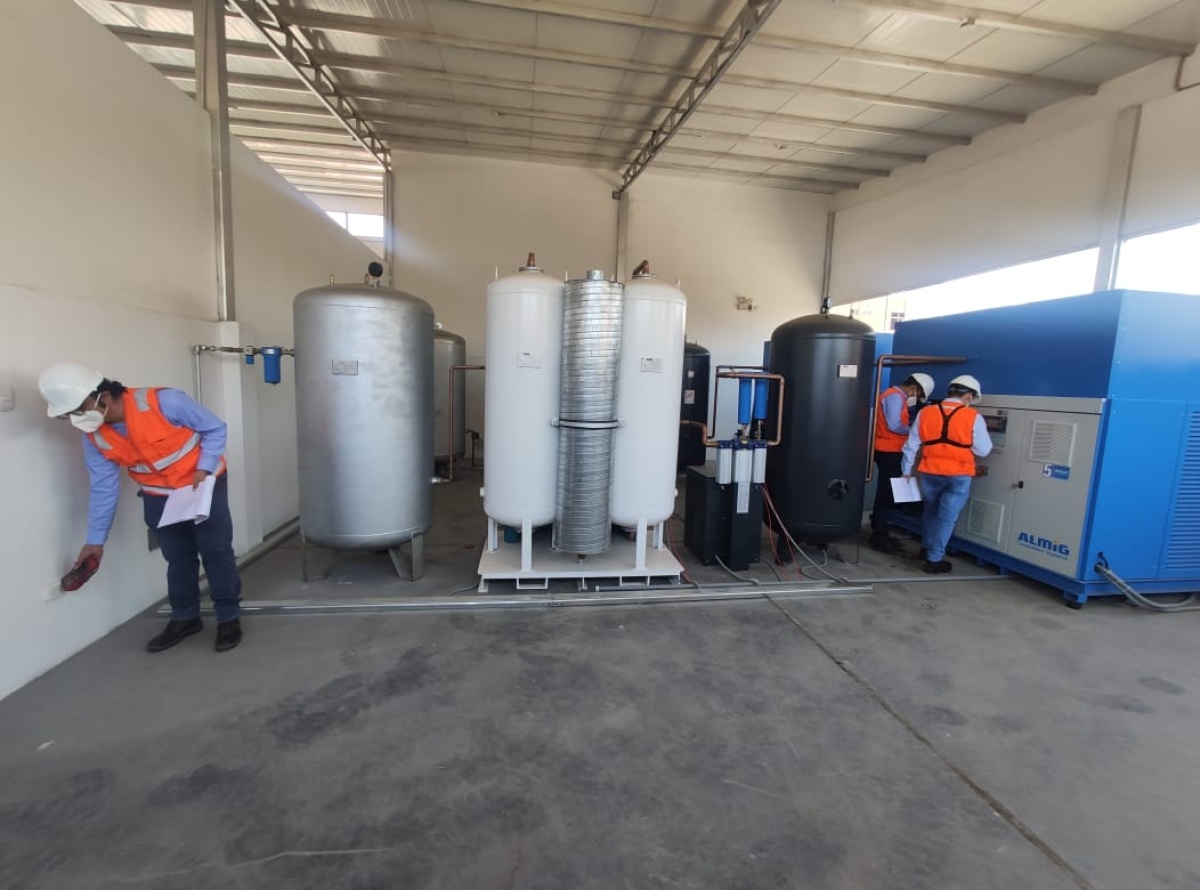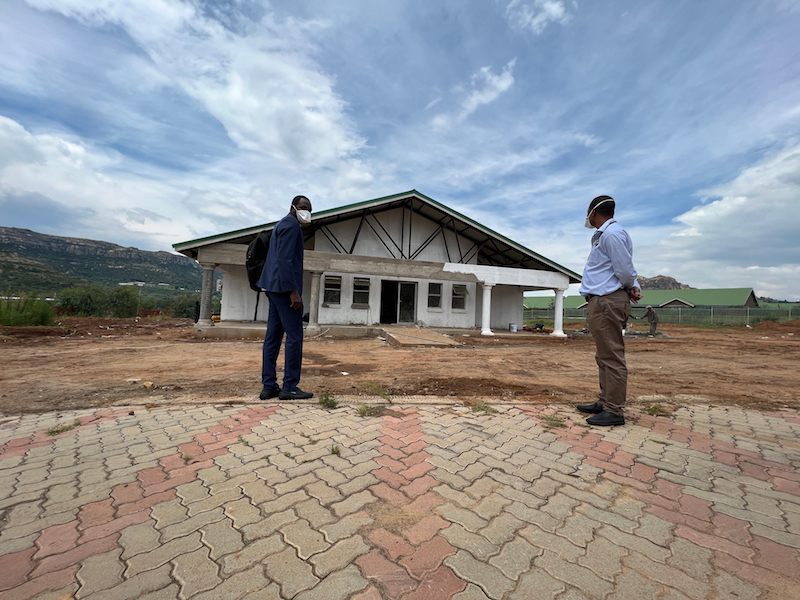BRING O2 To Fill Oxygen Gap in Five Countries
New PIH-led initiative offers essential medical treatment, ‘Oxygen is life’
Posted on Mar 31, 2022

Dr. Paul Sonenthal will never forget the sounds that erupted in the ward day after day: patients suddenly gasping for breath, almost in unison.
This painful soundtrack stemmed from oxygen deprivation. At the small, regional hospital where Sonenthal worked, oxygen was delivered to patients from a single cylinder that required daily refilling by clinicians and staff.
“When the patients started screaming, a few of us would sprint out, grab a backup 100-pound cylinder, and bring it to the ward,” Sonenthal recalled. “When we’d open the valve and the oxygen started flowing again, the gasps would stop.”
Even before the COVID-19 pandemic, the lack of medical oxygen in impoverished regions worldwide was a crisis: 9 in 10 hospitals in low-and middle-income countries lacked access to oxygen therapy. It’s hard to quantify the number of deaths linked directly to the oxygen gap, but it is estimated that as many as 320,000 pneumonia deaths a year could be prevented by increasing access to oxygen therapy. And that doesn't include COVID-19.
COVID-19, a respiratory virus that, in severe cases, can leave patients desperate for supplemental oxygen, only deepened the crisis. A year into the pandemic, it is estimated that only 40% of health care facilities in low-to-middle income countries have a reliable oxygen supply. Without medical oxygen, nearly 1 in 5 people with COVID-19 will die. In hard hit countries, thousands of people literally suffocate to death due to inadequate supply of affordable oxygen.
A new initiative, BRING O2, will help accelerate access to safe, reliable, and quality oxygen in Malawi, Rwanda, Peru, Lesotho, and Madagascar. To explain this just-launched collaboration, and offer details on the global oxygen crisis and plans to address it, we spoke to Sonenthal, an associate physician in the Division of Pulmonary and Critical Care Medicine at Brigham and Women’s Hospital in Boston and associate director of inpatient medicine for Partners In Health; Dr. Melino Ndayizigiye, executive director of Bo-mphato Litsebeletsong Tsa Bophelo, as PIH is known in Lesotho; and Dr. Marco Tovar, medical director at Socios En Salud, as PIH in known in Peru.
How dire is the oxygen shortage right now, as we enter the third year of the COVID-19 pandemic?
Sonenthal: It is estimated that 38 million patients were admitted to hospitals in low-to-middle income countries in 2020 for hypoxemia, which is when blood oxygen levels become dangerously low. It’s hard to quantify the total number of deaths linked directly to the oxygen gap, but the Clinton Health Access Initiative estimated that 800,000 children died due to lack of oxygen. And that was before COVID-19.
For people in wealthy countries, it’s difficult to imagine a hospital without oxygen. There are so many respiratory conditions, and now COVID-19, that require oxygen, it seems basic.
Sonenthal: I agree. Oxygen isn’t a disease specific treatment; for a hospital, oxygen is like gauze or syringes—something a health care system needs just to function. There are so many diseases, chronic and acute, that require oxygen. When you go to the hospital with an acute illness, there is a good chance you’ll need oxygen. Without it, you are missing a fundamental part of the hospital.
What’s the new initiative, BRING O2, and how will it address the problem?
Sonenthal: With funding from Unitaid and in partnership with Build Health International (BHI) and PIVOT Health Madagascar, PIH has launched Building Reliable Integrated and Next Generation Oxygen Services, or BRING O2, to accelerate access to safe, reliable, and quality oxygen in Malawi, Rwanda, Peru, Lesotho, and Madagascar. Why those countries? Broadly speaking, they are all high priority based on need.
Ndayizigiye: For context, in Lesotho, we have realized the need for oxygen for a very long time. Before COVID-19, we had been importing oxygen from South Africa. With the surge of COVID-19, we realized that the demand for oxygen was huge, and South Africa began saying, ‘Now we want to serve our own patients,’ so Lesotho was left without support. PIH helped to build the country’s first oxygen plant in December 2020. We were able to supply oxygen to many facilities, but we couldn’t meet the demand. When the Ministry of Health decided to establish additional PSA (Pressure Swing Adsorption) plants, another issue came up: those plants didn’t have mechanics who knew how to run them. Pressure swing adsorption uses high pressures and a sponge-like material to pull nitrogen out of the air, leaving mostly oxygen. It requires specialized staff to run and maintain, and many of the existing plants were non-functional due to lack of technicians and training. Unitaid is helping with that training and recruiting more biomedical engineers to maintain and develop the plants.
Now as we are thinking beyond COVID-19, there is so much need for oxygen. People working in mines develop chronic lung disease from toxic exposures. Lesotho has the highest tuberculosis incidence in the world, and patients not only need drugs, they need oxygen. I remember a 32-year-old ex-miner who was diagnosed with drug-resistant tuberculosis and referred to us. His breathing was labored and his oxygen levels were very low on admission. A chest X-ray showed damage to 75% of his lungs. We gave him medical oxygen therapy and treatment for drug-resistant tuberculosis. After a week on oxygen in the ICU, giving the medication time to start working, his breathing became less labored and his oxygen saturations improved.
He is now healed and was discharged home to his family. Without medical oxygen, this young man would have died. Oxygen is life.

Tovar: Peru is the country hardest hit by COVID-19. We have the highest death rates per capita, highest case rates, and this has been driving and expanding the need to access oxygen. The oxygen gaps reported by the government were difficult, but we found even more gaps. We are gathering data only for three hospitals north of Lima, and we found from April through December 2020, more than 2 million hospitalized patients required oxygen, and another 2 million needed oxygen at home. But more than 225,000 people died, either at home or on public roads, in need of oxygen.
Sonenthal: What Dr. Tovar and the team at Socios are doing here is so important. We don’t know how many people are dying at home without oxygen. And without pulse oximeters, it’s hard to know. The thing about oxygen is you need the right amount at the right time in the right place, and this requires strong health systems. Many people emphasize how hard it is to quantify oxygen demand, but when it comes to oxygen, we can be certain about one thing: we don’t have anywhere near enough, and people are dying without it.
What are some of the other challenges countries face in getting oxygen to patients?
Sonenthal: Even in places where there is enough oxygen, there is no oxygen security. Without a backup generator, a PSA plant delivering piped oxygen across a hospital becomes worthless during a power outage. A surge of hypoxemic patients with COVID-19 suddenly increases demand for oxygen three-fold, outstripping supply. During a surge, a large referral hospital may be able to meet its own demand, but may no longer be able to send excess oxygen to smaller hospitals in the region, which are unable to give medical oxygen to their patients as a result.
Even with stable electricity and no demand surge, PSA and concentrator-produced oxygen require constant, careful maintenance. A clogged filter or tube can jeopardize oxygen supply. The technology was not built to run on its own—you need mechanics for maintenance.
Some hospitals rely on oxygen tank delivery, which has the benefit of needing no electricity or complex engineering to operate. However, any disruption in the supply chain can be devastating: from production issues, resource rationing, unsafe borders, flooded roads, theft...the list goes on and on.
Reliable oxygen delivery systems must be built with redundancy in order to ensure consistent access to oxygen. Hospitals that use PSA plants need a secondary supply of backup cylinders for power outages; hospitals that rely on tank delivery need bedside concentrators and back-up generators to fill gaps when deliveries arrive late. Whole oxygen delivery ecosystems must be created to ensure supply.
Ndayizigiye: We are working in the mountains, in remote regions. Someone might be having an asthma attack and even if you have a car or an ambulance, if you have no oxygen, it’s unlikely the patient will make it to the ICU in the referral hospitals. Lesotho has one of the lowest life expectancies in the world: 53, compared to the global average of 74. The leading causes of death are chronic and acute conditions, pneumonia, HIV, TB. You can imagine, in the context of COVID-19, what happens to life expectancy without adequate tools and supplies like oxygen?
Tovar: One thing I’d like to add is when you offer important medicine, when you give the oxygen to people in the hospitals, you create new trust in the health system.
Sonenthal: Exactly. If people know when you go to the hospital with COVID-19, you will get high-quality, supportive care including oxygen, this will build trust.
Beyond the current crisis, what is the long-term goal of this campaign?
Ndayizigiye: BRING O2 will strengthen oxygen ecosystems so that patients will no longer have to struggle to breathe. This will save lives during COVID-19 and beyond. As for the nuts and bolts, from December 2021 through November 2022, we are conducting on-site assessments in the five target countries and then doing everything from building new oxygen production plants and repairing broken or malfunctioning plants to overall improvements in facility infrastructure, as well as providing comprehensive training for biomedical engineers and clinicians. The long-term vision is to improve local biomedical and clinical capacity and strengthen the entire oxygen ecosystem at the national level.
Tovar: We need to reduce the oxygen gap, but it’s not enough. We need to try to strengthen the health system.
Sonenthal: That’s right. Rather than just responding to or planning for the next pandemic, PIH has always used health crises to build and strengthen health systems. Responding to the AIDS pandemic, we built hospitals, not for AIDS alone but to provide comprehensive health care from maternity care to surgery. When the 2010 earthquake hit Haiti, PIH had the oxygen, surgical supplies, and drugs to support 10 operating rooms that performed over a thousand surgeries. When building health systems in the wake of the Ebola epidemic in Liberia and Sierra Leone, oxygen plants were central to our efforts. These same facilities are now working around the clock to provide oxygen for patients with COVID-19.

